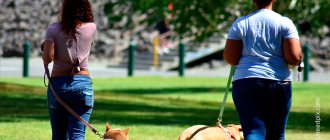Have you noticed that your dog doesn't bark like your neighbor's? For some owners, a dog that doesn't bark is something they can only dream of. But for others, it may be a cause for concern.
Dogs bark for a variety of reasons. In addition to warning trespassers to stay away or alerting you to a potential threat, your pet may bark because it's upset, bored, or simply wants your attention. Dogs also sometimes bark to express their emotions - fear, anger or excitement.
There are as many reasons why some dogs don't bark as there are reasons to bark. Here are some of the most common reasons why your dog isn't barking.
Why does a dog bark very little or be silent at all?
In order to know exactly how to help an animal cope with a quiet voice and so that the animal begins to bark normally, you need to consider in detail the main causes of this condition. Thus, there can be three causes of pathology:
- congenital or genetic problems. This is due to the fact that a small dog may have parents or other relatives who did not bark at all or did it very quietly;
- The main reason may lie in breed predisposition. Thus, some breeds, like bells, constantly bark, while others are silent and their eloquence can only be revealed by their eyes;
- fear of a pet or other stressful situation. This lack of barking by a dog can be attributed to the fact that it is constantly afraid of something and this affects its psycho-emotional state. Only some pets become aggressive due to stress, while others, in turn, withdraw into themselves and do not utter a sound. Thus, in order to eliminate the problem as much as possible and normalize your pet’s barking, you should definitely consult with a zoopsychologist, who will tell you a way out of the current situation.
The most sociable breeds
When you decide to buy a puppy, pay attention to the breed. Some pets are overly “social” by nature. To raise such dogs, you need to put in a lot of effort. The table will tell you which breeds are the loudest.
Table - Classification of dog breeds according to their tendency to bark
| The loudest | They bark in moderation and to the point | Silent people |
| — Bloodhound; - Sheltie; - Brussels Griffon; - dachshund; - Border Collie; - chow-chow; - drathaar; - Shih Tzu; - Yorkshire Terrier; - miniature schnauzer; - Weimaraner; - fox terrier; - Cocker Spaniel; - chihuahua; - collie; - fox terrier; - Maltese; - Samoyed dog; - Pekingese; - miniature poodle; - miniature pinscher; - shorthaired pointer; - Newfoundland; - toy poodle; - Pomeranian Spitz | - Alabai; - Boerboel; - Afghan hound; - Scotch Terrier; - Dogue de Bordeaux; — Giant Schnauzer; - Boston Terrier; - German dog; - briar; - Rottweiler; - bulldog; - Rhodesian Ridgeback; - bobtail; - pointer; - bull terrier; - Labrador Retriever; - Staffordshire Terrier; - royal poodle; - Dalmatian; - German Shepherd; - Doberman; - Airedale Terrier; - Irish wolfhound; - Golden retriever | — Irish Setter; - Staffordshire bull terrier; - Shar Pei; - Akita Inu; - English Mastiff; — basset hound; - Japanese chin; - Bichon Frize; - Cane Corso; — pug; - boxer; - bullmastiff; - Shiba Inu; - Basenji; - English bulldog; - Bernese Mountain Dog; - Papillon; - St. Bernard; - Chinese Crested Dog |
Why doesn't my domestic dog bark at all and what can I do about it?
In order for the animal to start barking normally, we can suggest that breeders pay attention to certain recommendations:
- Initially, you need to wait for the right moment when the dog barks involuntarily and immediately praise or reward it for such active actions. Here you can also time the command “Voice!” By pronouncing this word exactly at the time of barking, you show your pet that it is after these words that he should begin his bark. During such training, the pet will understand what is wanted from it and after this command it will actually begin to emit the coveted bark.
- If the previous advice did not produce results, then during a walk it is necessary to conduct a joint lesson in teaching this command with the dog that has learned it quite effectively. This is necessary because the ability of dogs to imitate each other is simply limitless and when your pet sees another dog barking after the cherished command, he will begin to copy him quite actively.
- Teaching the command “Voice!” can be accompanied by tasty or interesting rewards. Thus, if your puppy really likes to play, then the prize for obedience can be a new ball, and if the food is very tasty, then a treat. To do this, when pronouncing the command, you need to move the prize in front of the dog, and it will start barking, which will be proof that the training is moving in the right way.
Or maybe they brought the dog?
It happens that a calm, balanced dog begins to get angry at one of the family members and barks at him. And in the presence of other members of the “pack” the pet behaves friendly. Why is this happening?
Most often, the dog is frightened (not intentionally) by an eccentric child. A preschooler can irritate a four-legged pet with endless squeezing and attempts to take away dog toys. If you notice that your pet is offended by one of your loved ones, try to find out what this is connected with. It is possible that the dog is the injured party in a conflict unknown to you. This means that children need your stern reprimand.
Relationship between pet and person
In order for the dog not to encounter such a problem as the lack of barking in adulthood, he must be taught to bark from infancy. Compliance with this rule does not depend at all on the breed or genetic predisposition of the animal. This is due to the fact that the person must always dominate the dog and all attempts by the pet to reverse must be immediately stopped. The basis of a healthy relationship is complete submission to your owner, obedience and proper routine. However, in addition to all this, you must show your pet your good attitude and love.
The dog feels all your manifestations and only with complete trust and safety will it be able to fully open up and begin to bark exactly when it is necessary. Training will begin to be carried out more effectively, and the pet will understand and do everything that is required of it.
Answer
A small puppy needs experience. Not having an adult dog around to bark creates difficulties. A child's bark sounds like a squeal. The baby attracts attention by making whining sounds.
The dog squeals when he is sick. The babies are shown to veterinarians. The dog can get sick and die. The doctor will determine the source causing the suffering.
Sometimes the little ones squeal, imitating the behavior of dogs. This is how you get to know the world. It takes time to adapt. Perhaps the vocal cords have not had time to develop.
By making a sound, a four-legged animal shows its character. Thanks to barking and squealing, the dog attracts attention. Individuals who are three months old begin to bark fully. The early sounds made by the baby resemble an adult bark. They make squeals and yelps.
Principles and best period to start training a dog
Why a dog doesn’t bark at strangers passing by is a question that a fairly large number of breeders are faced with today. But the answer to it is not always unambiguous. But, in order to begin voice training for a pet, there are a variety of age indicators for each individual breed.
If your pet belongs to one of the aggressive breeds, then he will try to demonstrate all his protective qualities very early. In this case, such attempts must be significantly corrected and, if necessary, stopped by the owner.
However, as for the average period, it is not recommended to teach the dog to bark loudly and loudly until the dog is six months old. This is due to the fact that the baby’s psyche, which has not yet opened up, will not be able to perceive everything correctly and the pet may confuse barking with aggression, which will not do him any good. Such attempts at early training can lead to the animal becoming completely uncontrollable. For example, a dog may obey its owner, but be aggressive towards other members of the household.
Thus, the best age for a dog to train is from nine to twelve months.
It is during this period of his life that the puppy’s fervor will subside a little, and the dog will be able to significantly control his emotions and perceive certain commands. Starting from this age, the dog will begin to significantly distinguish between its own and strangers; the latter will be greeted by a fairly loud bark.
Laryngeal paralysis
An interesting condition in which the windpipe fails to open normally with each breath and instead obstructs part of the animal's airway is called laryngeal paralysis. In principle, this condition occurs in dogs of any breed, but is most common in Labrador retrievers. The condition, we note, is quite dangerous. It affects not only the dog’s ability to bark – the dog often cannot eat, drink or swallow normally. This requires the intervention of a veterinary surgeon. If you notice that your dog, who barked without any problems yesterday, has stopped doing so today, immediately show him to a specialist.
Raising a defender
"Face", "Take" and "Alien"
In order for the animal to correctly distinguish between these commands, it is worth initially deciding what the dog’s reaction to them should be.
Thus, the “Alien” command means that danger is possible, but it has not yet arrived. Therefore, the pet must be alert and wait without making a single sound. All attempts to attack when this command is pronounced must be strictly suppressed, since it is this command that should bring the animal into full readiness, but not give it the opportunity to attack first.
In the same case, if the commands “Face” or “Take” are followed, the pet must react with lightning speed and pounce on the attacker. It is very important that such an attack is accompanied by loud barking. Only this can show that the dog is not joking and is quite aggressive.
Thus, if a dog can only yelp and no longer shows any signs of aggression, then it is necessary to work with it quite intensively. If necessary, you can seek help from professional dog handlers, who will be much more effective in helping with this issue.
Aggression towards strangers on the street
Dogs that “assert themselves”
There is no such term as "aggression for the purpose of self-affirmation", but this explanation is well understood by dog owners, so we use it. We are talking about pets who were initially incredibly loving, and then suddenly began to bite. The owners usually describe the problem in the following words: “The dog was fawning on everyone, was ready to lick everyone it met, and then it came up to one boy and, apparently, he, so-and-so, did something to her, because she bit him and ran away . And after that she began to bark at people more and more often and bite when they tried to touch her.” It is typical that for the first time aggression manifests itself towards a child, and that the owners blame it not on the pet, but on the person, without understanding the whole picture.
In reality this is the case. Their dog was initially very fearful, and any communication with strangers was a burden and caused discomfort for her. She tried to protect herself with infantile behavior, which her owners considered to be a sign of friendliness. She fawned: she wagged her tail between her legs, lay down on the ground (signs of fear), and when they leaned over her (further enhancing the animal’s sense of threat), she raised her head and tried to lick the person’s face or hands, perhaps while doing so she began to pee a little, and then she fell on her back and exposed her stomach. The dog showed submission, so that it would not be touched, left alone, and people believed that, on the contrary, it wanted to be petted.
With age and experience, the dog began to understand that her submission did not bring her what she wanted (more precisely, on the contrary), she herself became more confident in herself and, at some point, with a child, whom she was less afraid of than an adult, she tried a different tactic - aggression. It immediately worked: the animal was left alone! After one, second, third incident, the dog became convinced that aggression was the best way to get rid of annoying touches, so the problem began to intensify sharply, eventually turning into the dog itself chasing and attacking strangers, forcing them to jump away , withdraw your arms or legs. This aggression is especially often directed at running people or cyclists, since the dog thinks that they are running away from it, and this also reinforces it to act in the same spirit.
The method for correcting aggression without a specialist will be the same as we described above. But preventive measures here may be completely different. First, if you recognize your dog's behavior in the description, then begin to respond appropriately to his displays of submission and do not allow strangers to pet him if he shows signs of fear. If the dog wags his tail between his legs and crouches to the ground, and you need to touch him (to put on a harness, for example), then squat down, do not hang over him. Once you have put on the harness, remain seated next to your dog, but do not touch him. You can put your hand towards her, but do not stroke her until she herself puts her head under your palm. Let her decide for herself whether she wants to stay close to you or wants to move away - and if she wants to move away, then let her do it. If she puts her head or back under your palm, stroke with a few strokes and move your hand away a little, thus again offering your pet a choice.
Learn to stand up for your pet's interests (and yours), and do not allow your dog to be petted when it is not comfortable. At the same time, if you want to teach your pet to correctly perceive the touches of strangers, you can use the same approach as when training to unpleasant procedures. In this case, your goal becomes the following behavior: when a passerby pets your dog in the future, he will perceive this as a learning situation and look back at you to get the praise and treat he deserves. For her, the touch of a stranger will become the same procedure as cleaning her ears: not particularly pleasant, but it’s not difficult to endure and get a “salary.”
In order to teach your pet to react in this way, at the moment when a stranger wants to pet your fearful and submissive dog, turn its butt towards the stranger and, when he has petted the dog a little, say: “Well, we have to go!” and take your pet with you, praising and treating it. Do this every time until you see that the dog calmly reacts to a stranger and begins to wag his tail between his legs. You can also ask people you know to rehearse similar situations with you and your dog. In this case, start training with those your pet knows and likes, so that it is easy for him to demonstrate the behavior you want and receive encouragement, and later move on to training with people less familiar to the dog. After a few weeks of repetition, the pet that initially cowered when you exposed its back for stroking now remains calm, tail down and looking at you, awaiting your praise and treats. This is the dog’s real motivation: to communicate with the owner and receive reinforcement. Now the presence of a stranger does not oblige her to somehow cope with the situation herself, to be friends with him or to conflict. She is simply “working out” the scenario—receiving reinforcement for allowing this stranger to touch her. Such a dog has given control of the situation into your hands, it feels confident, and it has no need to “assert itself” at the expense of athletes and cyclists “running away from it.”
Life story
This is my first dog. <…> He was a very active puppy with a positive attitude towards people. He was like a little armored car, he went where he wanted, chewed things (furniture, shoes), and bit his hands very painfully. Bited the leash while getting dressed. He wrote at home wherever he found himself in need. Today I know that this is normal puppy behavior and needs to be directed in the direction we want. <…> I myself didn’t know how to cope at all. I started looking for help. And read about the kennel clubs of our city. With all these questions, I turned to one of the dog handlers. As I realized later, it was not very successful. All recommendations for puppyhood were correct and helped solve most problems, with the exception of one. The dog handler suggested solving the problem of strong biting by laying the puppy down (“alpha coup”). And it’s good that I didn’t persist for too long with this method. I realized that it does not solve the problem with biting at all, but only drives the puppy into a terrible state, and me too. <…> When Veles was eight months old, I returned to our first dog handler for obedience work. His method included jerks, a whip, a strict collar, and an EShO. I caused severe damage to my dog by taking this course. After him, Veles showed a strong reaction to people in confined spaces. I was mistaken. Veles had a persistent reaction of aggression to moving (active) and noisy children. And as I wrote above about entrances: a strong fear of people suddenly appearing in confined spaces. Such as entrances (the strongest reaction), any doors, the courtyard of our house (especially when passing by the entrance doors), narrow alleys, paths, roads. That is, all those places where there is no possibility of escape. The reaction of fear aggression (barking, throwing) always appears at the entrance. Today I work with animal psychologists, and gradually the problems are being solved. <…> I really want to protect you, those who will read about my experience, from such training methods. Anna Koroleva about Veles (mongrel, male, approximately 3 years old)
next page>>>
Puppy vision development
Animals are born blind. The first two weeks are guided by smells. Next, attempts to master the limbs begin. They are trying to get up, learning to walk.
The eyes open after two weeks. Later - in individual individuals. This means the little animal is weak. Health status is checked.
Vision appears on the fourth day of open eyes. Some begin to see earlier, after a day. Until eighteen days of life, puppies are prohibited from opening their eyes.
The period for the development of vision varies around twenty days. If vision does not appear, you need to visit a doctor. Independent eye opening occurs after eighteen days of life. Care is required.
Use a sterile cloth soaked in warm water to wet the eye. New tissue is used for the other eye. With clean hands, carefully open the eyelids. Dogs do not open their eyes on their own due to pain from severe blinding.











